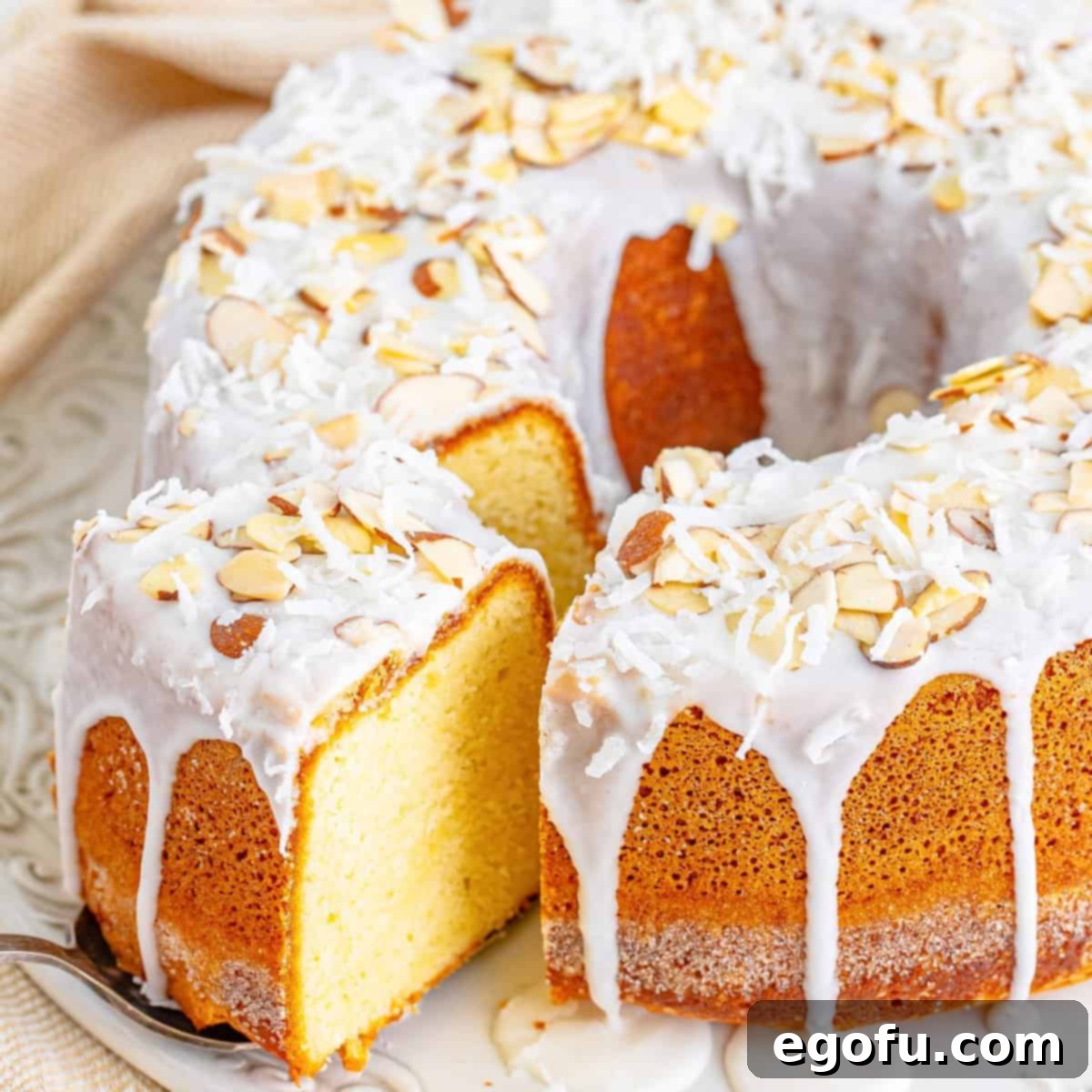The Ultimate Homemade Louisiana Crunch Cake: A Southern Gem
Prepare to impress with this magnificent, homemade Louisiana Crunch Cake, a true Southern classic. Each slice offers a symphony of tender, buttery pound cake perfectly complemented by the delightful crunch of toasted coconut and sliced almonds. This isn’t just a dessert; it’s an experience, a taste of authentic Southern baking that promises to leave a lasting impression.
Unveiling the Louisiana Crunch Cake: A Signature Southern Pound Cake
The Louisiana Crunch Cake stands out as a luxurious, buttery pound cake, known for its moist crumb and distinctively sweet, crunchy topping of coconut and almonds. If you’ve ever tried a store-bought “crunch cake” and found it lacking, rest assured—this homemade version transcends those expectations. Unlike the Chicago version popularized by brands like Entenmann’s, our recipe delves into the heart of Southern baking, offering a depth of flavor and texture that only a scratch-made cake can provide.
At first glance, the ingredient list for this delightful dessert might seem extensive, but don’t let that deter you. Each component plays a crucial role in creating the cake’s signature taste and texture. You’ll find that the preparation comes together more quickly than you might anticipate, and the reward is absolutely worth every moment spent in the kitchen. For those who prefer a quicker route without compromising too much on flavor, we even provide a reliable cake mix variation later in this guide. Whether you’re a seasoned baker or new to the art of making pound cakes, this recipe is designed to guide you to success, resulting in a show-stopping dessert perfect for any occasion.

Frequently Asked Questions About Louisiana Crunch Cake
A Louisiana Crunch Cake is a distinctive type of pound cake, celebrated for its rich, tender interior and a unique crunchy texture. This “crunch” element is ingeniously incorporated by lining the bottom of the pan with a mixture of sugar and coconut flakes before baking. Once inverted, this forms a sweet, caramelized crust. Additional crunch comes from a generous sprinkling of sliced almonds and coconut on top, often adhered by a pourable glaze. While the exact origins of this cake remain somewhat of a mystery, with little documented history, it’s widely believed to be a creation born out of Louisiana’s vibrant culinary traditions, reflecting the region’s love for pecans, sugar, and rich desserts.
The delightful crunch factor in a Louisiana Crunch Cake comes from two primary sources. Firstly, a layer of sugar and coconut flakes is spread at the bottom of the tube pan before the batter is added. During baking, this mixture caramelizes and adheres to the cake, forming a sweet, crisp crust on what becomes the top once the cake is inverted. Secondly, after the cake is baked and glazed, a generous topping of sliced almonds and additional sweetened coconut flakes is sprinkled over the wet glaze, ensuring they stick and provide a secondary layer of textural contrast. Without these crucial coconut and almond elements, you would essentially be enjoying a delicious homemade pound cake, but it wouldn’t quite capture the authentic “crunch” experience this Southern dessert is known for.
For this particular recipe, a large 10-inch tube pan is highly recommended. The design of a tube pan, with its central cone, promotes even heat distribution, which is ideal for baking dense pound cakes thoroughly. While you might be tempted to use a Bundt pan, exercise caution. Standard Bundt pans typically have a capacity of 10-12 cups, which may not be sufficient for the full volume of batter this recipe yields. Using a standard Bundt pan could result in the batter overflowing during baking, leading to a messy situation and an incomplete cake. If you insist on using a Bundt pan, ensure it is an extra-large version with a capacity of at least 15 cups to accommodate all the batter without issues. Otherwise, stick to a classic tube pan for the best results.
While you certainly can omit the coconut from this recipe if you truly dislike it, it’s important to understand that the coconut is a fundamental component of what defines a “Louisiana Crunch Cake.” The unique flavor profile and textural contrast derive significantly from the coconut flakes both baked into the crust and sprinkled on top. Removing it would transform the cake into a delicious almond pound cake, but it would lose its distinct Louisiana Crunch identity. If you’re hesitant but open to trying, consider reducing the amount rather than eliminating it entirely, or compensate with extra almond extract and sliced almonds for a different, yet still delightful, experience.
Absolutely! For a quicker, slightly softer version, you can adapt this recipe using a cake mix. Keep in mind that a cake mix version will yield a cake with a lighter, softer crumb compared to the denser, more traditional pound cake texture achieved from scratch. Here’s a simple cake mix variation:
- 1 box French vanilla or yellow cake mix
- 1 box instant vanilla pudding (small size)
- 1 cup full-fat sour cream
- ¾ cup vegetable oil
- ½ cup milk
- 4 large eggs
- ⅓ teaspoon almond extract
- 1 teaspoon vanilla extract
Directions for Cake Mix Version:
Thoroughly spray a 10-cup Bundt pan with non-stick cooking spray that contains flour (such as Baker’s Joy). Prepare the pan with ¼ cup granulated sugar and ¼ cup sweetened flaked coconut as directed in the original recipe (Steps 8 & 9 below). In a large bowl, combine the cake mix, instant pudding, sour cream, vegetable oil, milk, eggs, almond extract, and vanilla extract. Beat with an electric mixer until well combined and smooth, about 2 minutes. Pour the batter over the coconut and sugar layer in the prepared Bundt pan. Bake at 325°F (160°C) for approximately 40-45 minutes, or until a toothpick inserted into the center comes out clean. Let it cool in the pan for about 20 minutes before inverting. Once completely cool, prepare the glaze and drizzle it over the cake, then immediately garnish with the remaining coconut and almonds. This method will produce a slightly smaller cake than the scratch recipe.
While some traditional baking recipes strictly recommend sifting flour to achieve a finer crumb and prevent lumps, it’s not always a mandatory step, especially with modern flours. For this Louisiana Crunch Cake, sifting the flour is entirely optional. Personally, I rarely sift flour, which might surprise some seasoned bakers. However, I find that my cakes consistently turn out beautifully light and tender without this added effort. Instead, I simply ensure the dry ingredients (flour, baking powder, and salt) are thoroughly whisked together in a bowl before incorporating them into the wet mixture. This effectively breaks up any potential clumps and evenly distributes the leavening agents.
This versatile cake can be served in a multitude of ways to suit any preference. It’s wonderfully delicious served at room temperature, allowing its rich flavors to fully develop. For an extra comforting treat, pop an individual slice into the microwave for about 15 seconds; a slight warmth truly enhances its tender texture and aromatic qualities. Beyond that, consider elevating your dessert experience by serving a slice with a scoop of premium vanilla bean ice cream, allowing the melting creaminess to complement the cake’s crunchy exterior. Alternatively, a dollop of freshly whipped cream and a scattering of seasonal fresh fruit, such as berries or sliced peaches, adds a vibrant, refreshing contrast to the cake’s richness. It’s truly a cake that shines whether served simply or dressed up.
Proper storage ensures your Louisiana Crunch Cake remains fresh and delicious for as long as possible. Leftover cake can be stored at room temperature, ideally in an airtight container or tightly wrapped in plastic wrap, for up to 5 days. This helps maintain its moisture and prevents it from drying out. For longer storage, this cake freezes exceptionally well. Wrap individual slices or the entire cooled cake tightly in multiple layers of plastic wrap, followed by a layer of aluminum foil, to protect it from freezer burn. When stored this way, the cake can be kept in the freezer for up to 3 months. To enjoy, simply thaw at room temperature before serving.
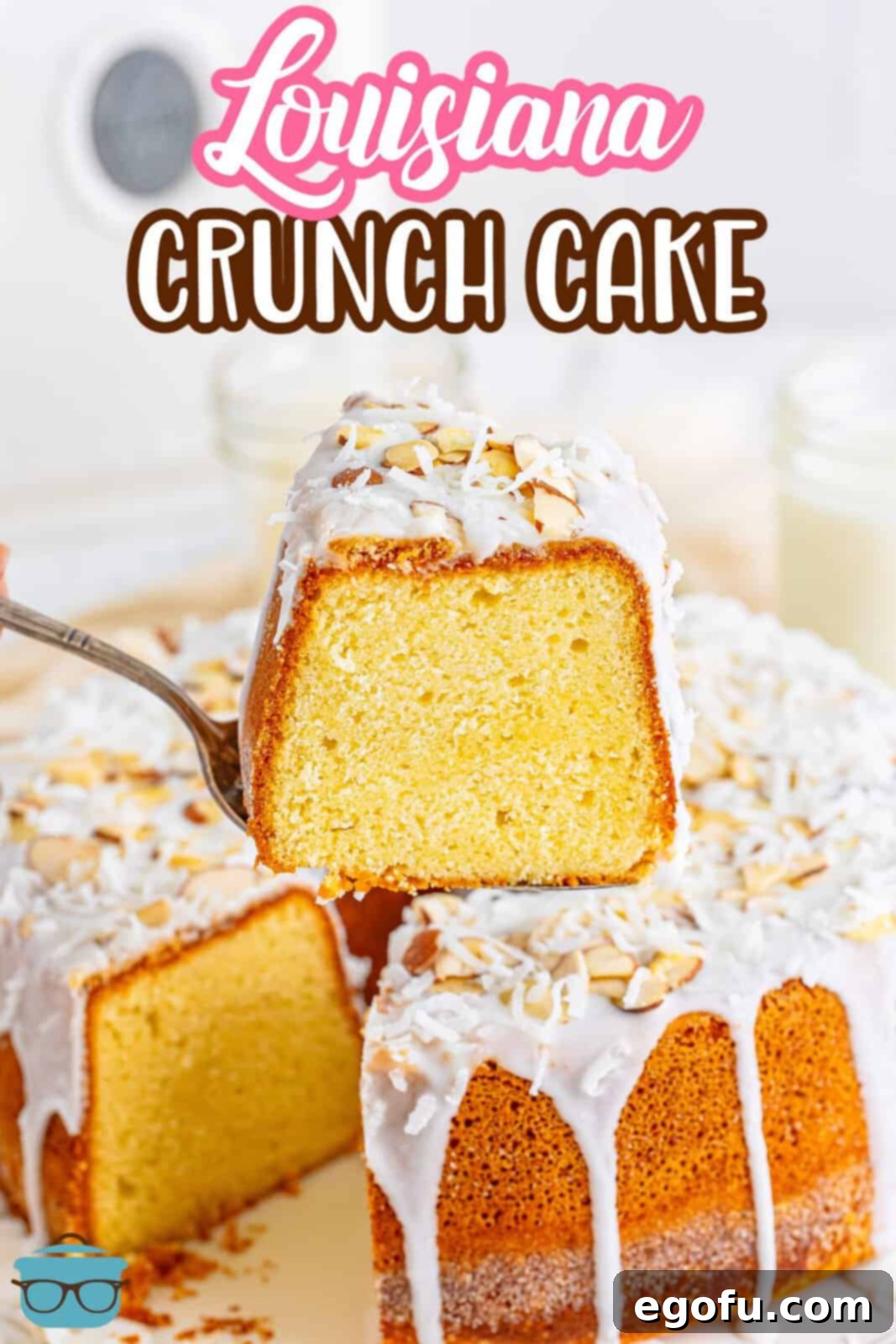
Essential Ingredients for a Perfect Louisiana Crunch Cake
Crafting the perfect Louisiana Crunch Cake requires a thoughtful selection of high-quality ingredients. Each item plays a specific role in achieving the cake’s signature tender crumb, rich flavor, and irresistible crunch. Here’s a closer look at the key components you’ll need, along with some helpful tips:
- All-Purpose Flour: This forms the foundational structure of our pound cake. While all-purpose flour works wonderfully, you can opt for cake flour if you prefer an even finer, more delicate crumb. Brands like White Lily all-purpose flour are often favored in Southern baking for their lower protein content, yielding exceptionally tender baked goods.
- Baking Powder: Essential for leavening, baking powder helps the cake rise and achieve a light, airy texture within its dense pound cake structure. Always check the expiration date; old or inactive baking powder is a common culprit for cakes that don’t rise properly. A simple freshness test involves mixing a teaspoon of baking powder with a bit of hot water—if it bubbles vigorously, it’s good to go.
- Granulated Sugar: Provides sweetness and moisture, contributing to the cake’s tender crumb. This recipe has not been tested with sugar substitutes, so results may vary if substitutions are made.
- Salted Butter: A key ingredient for a rich pound cake, butter contributes immense flavor and moisture. It’s crucial for the butter to be softened to room temperature before creaming with sugar. This process incorporates air, creating a light and fluffy base for the batter. If using unsalted butter, add an extra pinch of salt to the dry ingredients.
- Large Eggs: Eggs are vital for structure, richness, and binding the ingredients. For the best results, allow your eggs to come to room temperature. Room temperature eggs emulsify more effectively with the butter and sugar, leading to a smoother batter and a fluffier, more uniform cake crumb.
- Sour Cream: This ingredient is a secret weapon for adding incredible moisture and a subtle tang to the cake, balancing the sweetness. Full-fat sour cream is recommended for optimal richness. While untested, full-fat Greek yogurt might be a suitable substitute if you’re looking for an alternative, though it might alter the final texture slightly.
- Vanilla Extract and Almond Extract: The magical combination of these two extracts elevates the flavor of this cake to extraordinary heights. Vanilla provides warmth and sweetness, while almond extract adds a sophisticated, nutty undertone that pairs exquisitely with the coconut and almonds. If you’re not a fan of almond flavor, you can simply increase the amount of vanilla extract.
- Buttermilk: The acidity in real buttermilk reacts with the baking powder, contributing to the cake’s rise and tender texture. More importantly, the fat content in buttermilk adds significant moisture and richness, resulting in a wonderfully moist pound cake. Avoid using a homemade buttermilk substitute if possible, as real buttermilk yields superior results.
- Sweetened Flaked Coconut: This is non-negotiable for an authentic Louisiana Crunch Cake! It provides both sweetness and that irresistible textural crunch, distinguishing it from a plain pound cake. If you absolutely cannot tolerate coconut, you can omit it, but be aware that the cake’s characteristic identity will be altered.
- Coconut Extract: For an enhanced coconut flavor, especially if you’re not using a lot of coconut flakes, or if you want to ensure the coconut essence shines through. While optional, it deepens the tropical notes and creates a more cohesive flavor profile. Trust me, it’s a delightful addition!
- Sliced Almonds: These are integral to the “crunch” in our cake. Sprinkled on top, they add a delightful nutty texture and a beautiful visual appeal. For an even more pronounced flavor and crispness, consider toasting the sliced almonds lightly before use.
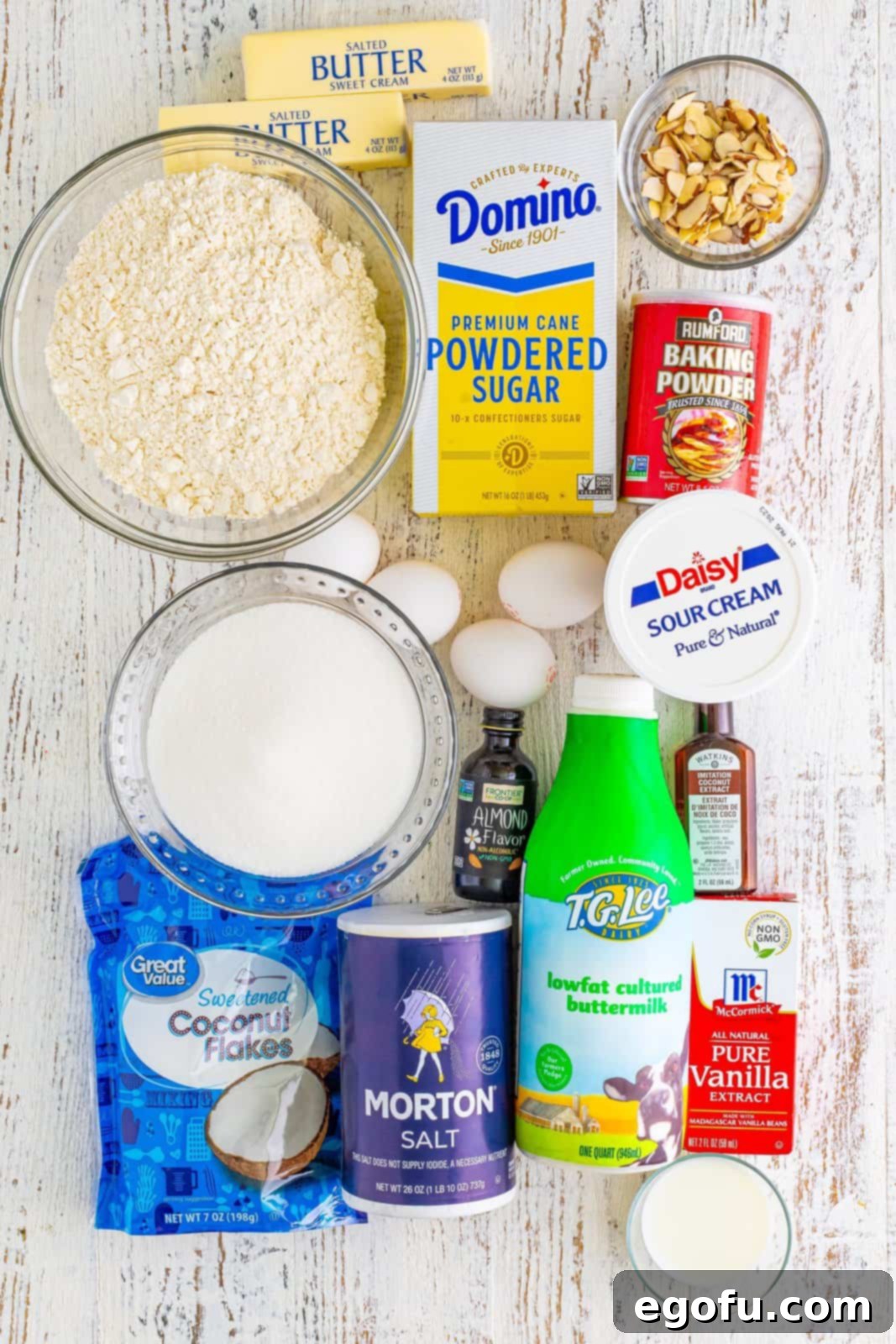
Baking the Perfect Louisiana Crunch Cake: Step-by-Step Guide
Creating this magnificent Louisiana Crunch Cake is a rewarding experience. Follow these detailed steps to ensure a moist, tender cake with that signature irresistible crunch.
Step 1: Prepare Your Oven and Pan. Begin by preheating your oven to a steady 350°F (175°C). This ensures the oven is at the correct temperature when the cake goes in, promoting even baking. Next, take your 10-inch tube pan and spray it thoroughly with a high-quality non-stick cooking spray, ideally one that contains flour. This crucial step prevents the cake from sticking and ensures a clean release later. Set the prepared pan aside.
Step 2: Combine Dry Ingredients. In a medium-sized bowl, whisk together the all-purpose flour, baking powder, and salt. Whisking ensures these ingredients are well combined and helps to break up any lumps in the flour, providing a consistent texture throughout the cake. Set this dry mixture aside.
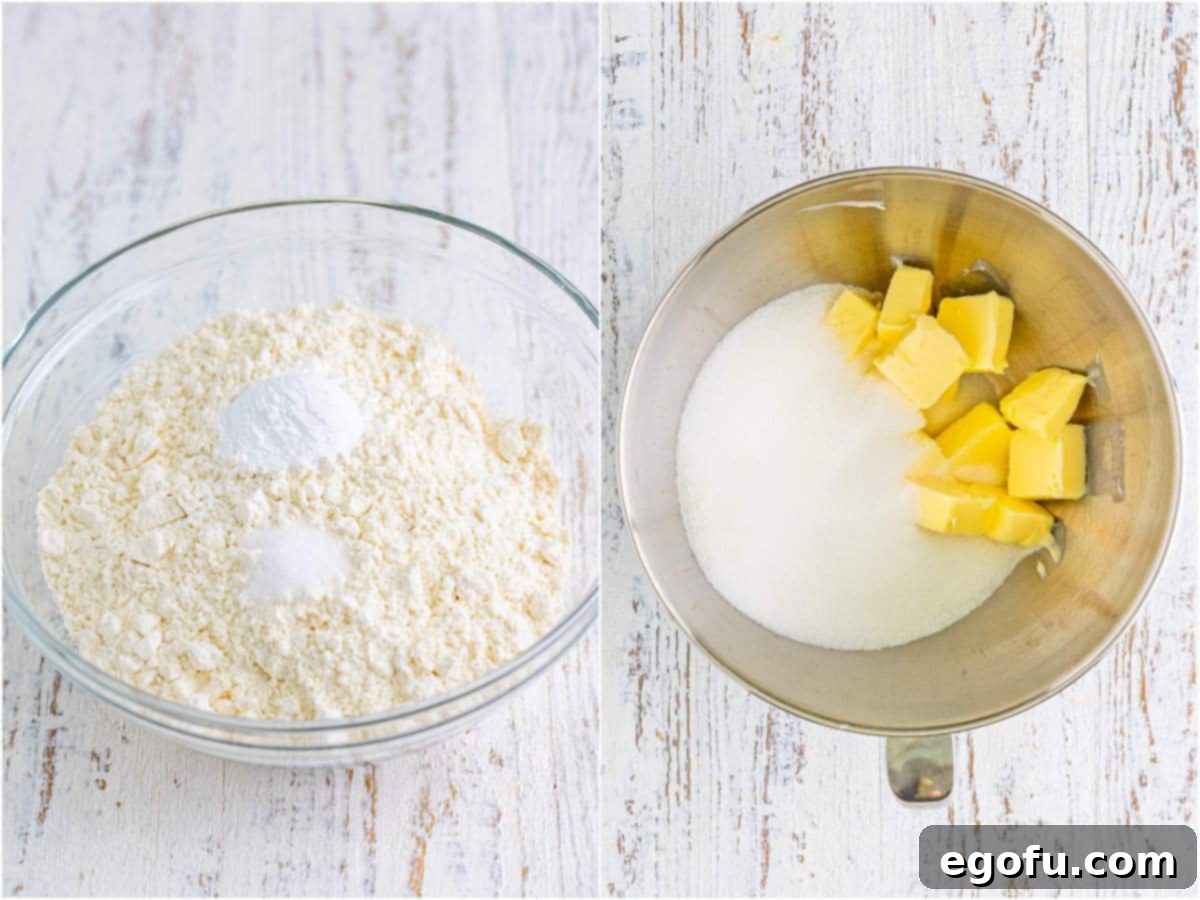
Step 3: Cream Butter and Sugar. In the bowl of a stand mixer fitted with the paddle attachment (or using a large bowl and a hand mixer), combine the softened granulated sugar and butter. Cream these two ingredients together on medium speed for a full 2 minutes. This process incorporates air into the mixture, which is fundamental for a light and tender pound cake texture.
Step 4: Incorporate Eggs and Extracts. Add the large eggs to the creamed butter and sugar mixture, one at a time. After each egg, mix thoroughly until it is fully incorporated into the batter before adding the next. This prevents the batter from curdling and ensures a smooth consistency. Once all eggs are mixed in, stir in the sour cream, vanilla extract, and almond extract until just combined. The sour cream adds moisture, while the extracts contribute depth of flavor.
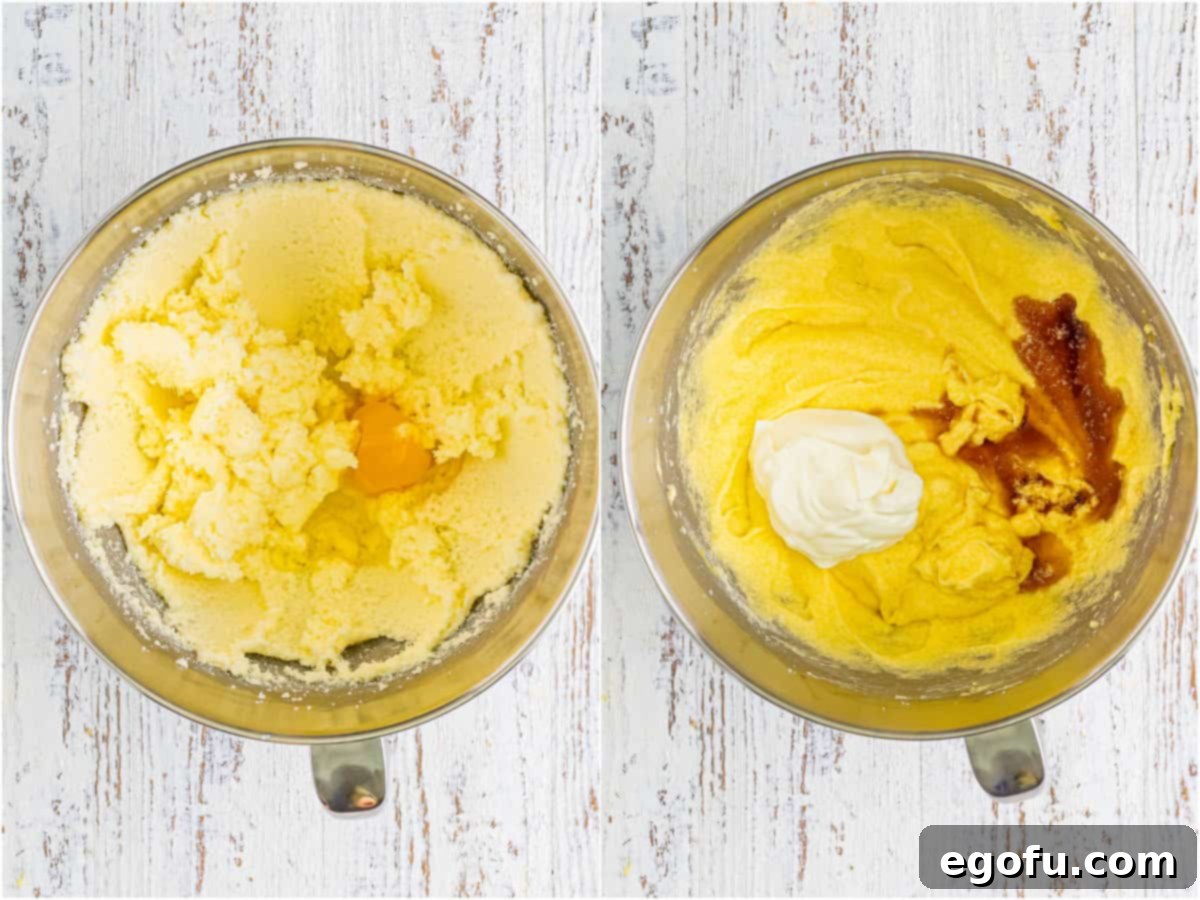
Step 5: Alternate Dry and Wet Ingredients. This step is crucial for achieving the perfect pound cake consistency. Begin by adding approximately one-third of the flour mixture to the wet ingredients. Mix on low speed until it is just combined, being careful not to overmix. Scrape down the sides of the bowl with a spatula as needed to ensure everything is incorporated. Next, add one-third of the buttermilk and mix until just combined. Repeat this process two more times, alternating between the flour mixture and the buttermilk, ending with the flour. After the last addition, mix until the batter is smooth and well blended. Always scrape the sides and bottom of the mixer bowl thoroughly to catch any unmixed ingredients.
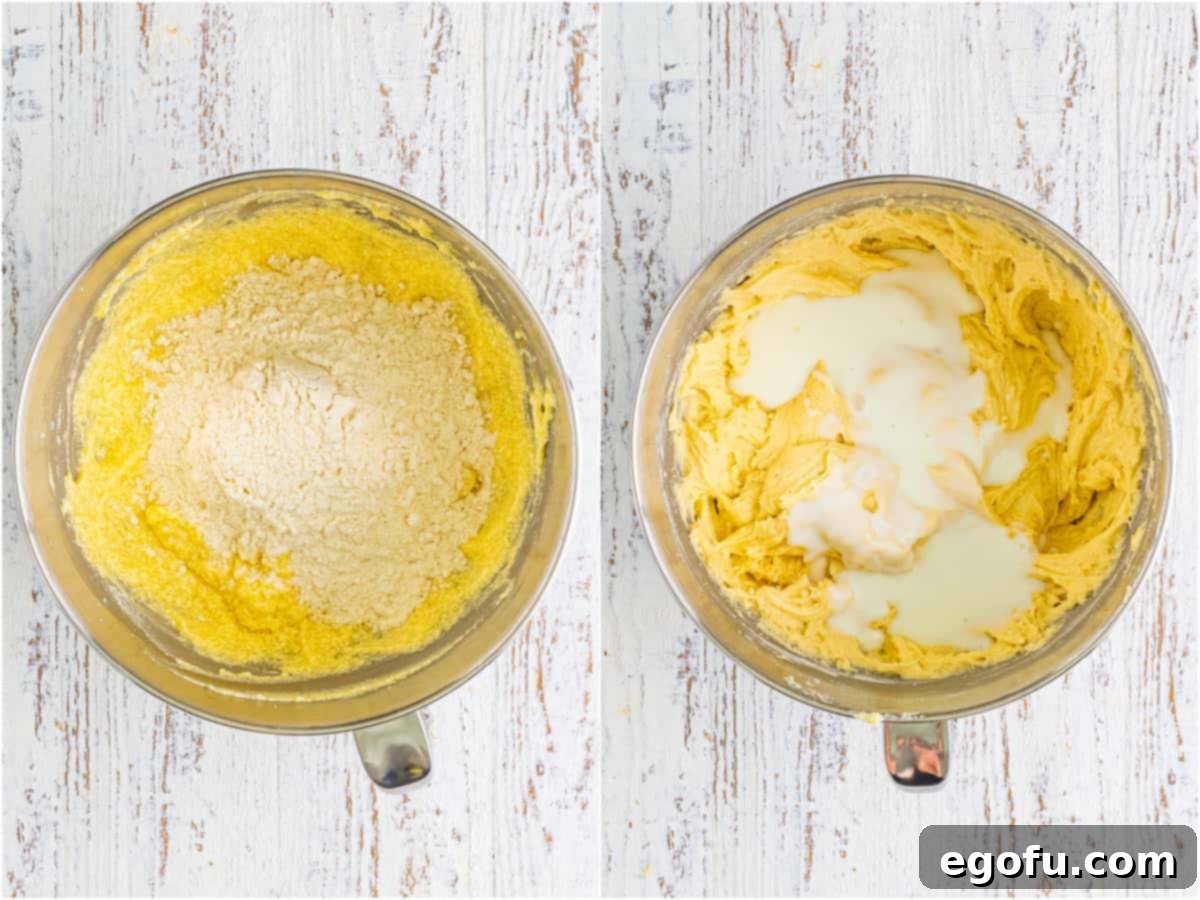
Step 6: Prepare the Crunch Topping in the Pan. Now for the signature crunch! Take your greased tube pan (not a Bundt pan unless it’s extra-large) and sprinkle ¼ cup of granulated sugar evenly across the bottom. Gently tap the pan and rotate it, allowing the sugar to adhere to the bottom and about 3 inches up the sides. This will create a beautiful caramelized crust. Next, evenly sprinkle ¼ cup of sweetened flaked coconut into the bottom of the sugar-coated pan. This forms the base of your crunch layer.
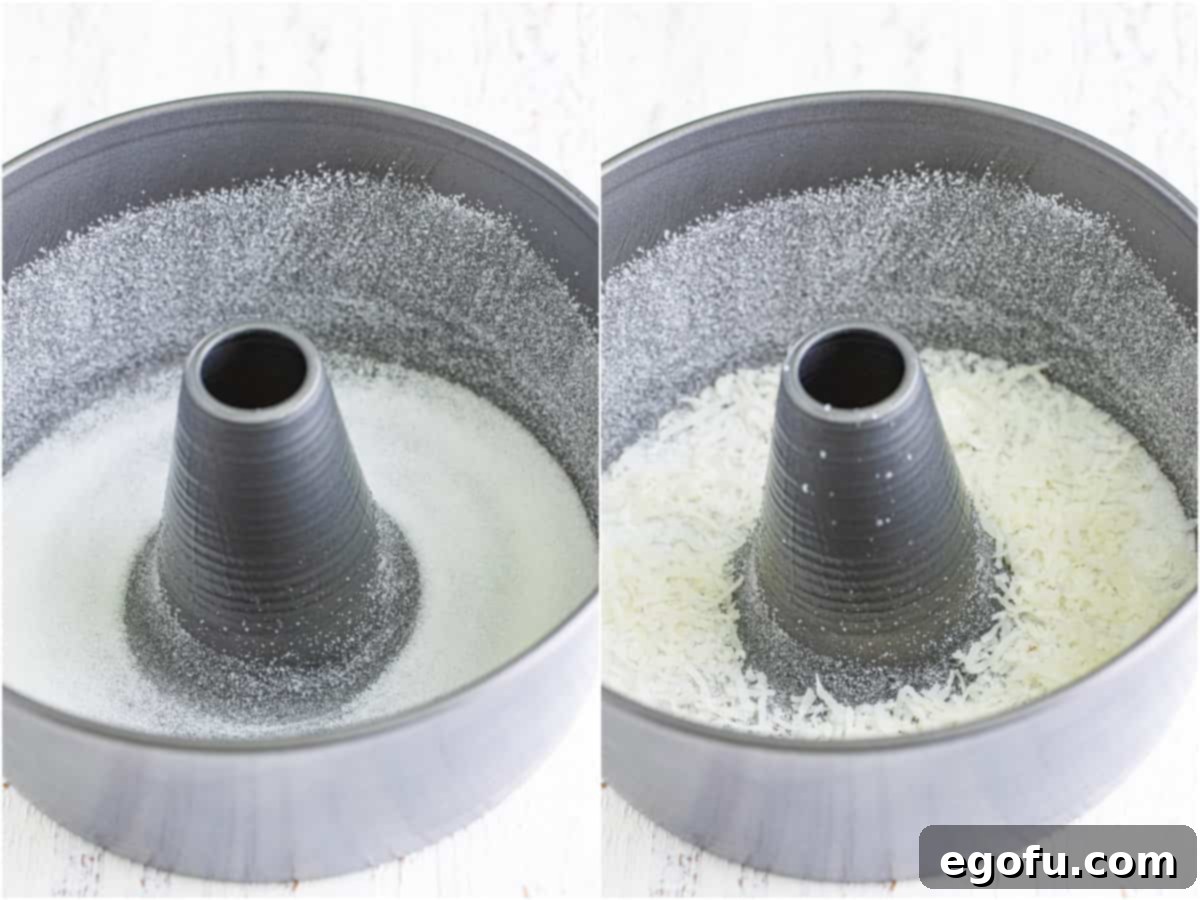
Step 7: Bake the Cake. Carefully spoon the cake batter into the prepared pan, spreading it evenly and smoothing out the top with a spatula. Place the pan in the preheated oven and bake for approximately 50-60 minutes. Baking time can vary depending on your oven, so rely on the toothpick test: insert a wooden toothpick or thin skewer into the center of the cake. When it comes out clean or with only a few moist crumbs attached, your cake is perfectly baked.

Step 8: Cool and Invert. Once baked, remove the cake from the oven and allow it to cool in the pan on a wire rack for precisely 10 minutes. This cooling period is important as it allows the cake to set slightly, making it easier to invert without breaking. After 10 minutes, place your desired serving platter or cake stand upside down over the pan. With oven mitts, carefully but confidently invert the cake onto the platter. Lift the pan, and the cake should release smoothly. Allow the cake to cool completely on the platter before proceeding to the glaze. A fully cooled cake ensures the glaze sets properly.
Step 9: Prepare the Glaze. While the cake is cooling, prepare the luscious glaze. In a medium bowl, whisk together the powdered sugar, 3 tablespoons of milk, ¼ teaspoon almond extract, ¼ teaspoon coconut extract, and ¼ teaspoon vanilla extract. Continue whisking until the glaze is completely smooth and free of lumps. The consistency should be thick enough to cling to the cake but still pourable. If the glaze seems too thick, add an additional tablespoon of milk, one teaspoon at a time, until you reach the desired consistency. If it’s too thin, add a little more powdered sugar. A pinch of salt in the glaze will also enhance the overall flavor.

Step 10: Glaze and Garnish. Once the cake is completely cool, generously pour the prepared glaze over the top, allowing it to slowly drip down the sides for a beautiful, rustic effect. Work quickly for the next step: immediately sprinkle the remaining ¼ cup of sweetened coconut flakes and ¼ cup of sliced almonds evenly over the wet glaze. The wet glaze acts as an adhesive, ensuring the garnishes stick firmly to the cake as it sets. This step is crucial for the final “crunch” and visual appeal.

Step 11: Set and Serve. Allow the glazed cake to sit undisturbed for at least 1 hour, or until the glaze has fully set. This ensures the topping is firm and doesn’t run when sliced. Once set, your magnificent Louisiana Crunch Cake is ready to be sliced and served. Enjoy every tender, crunchy bite!
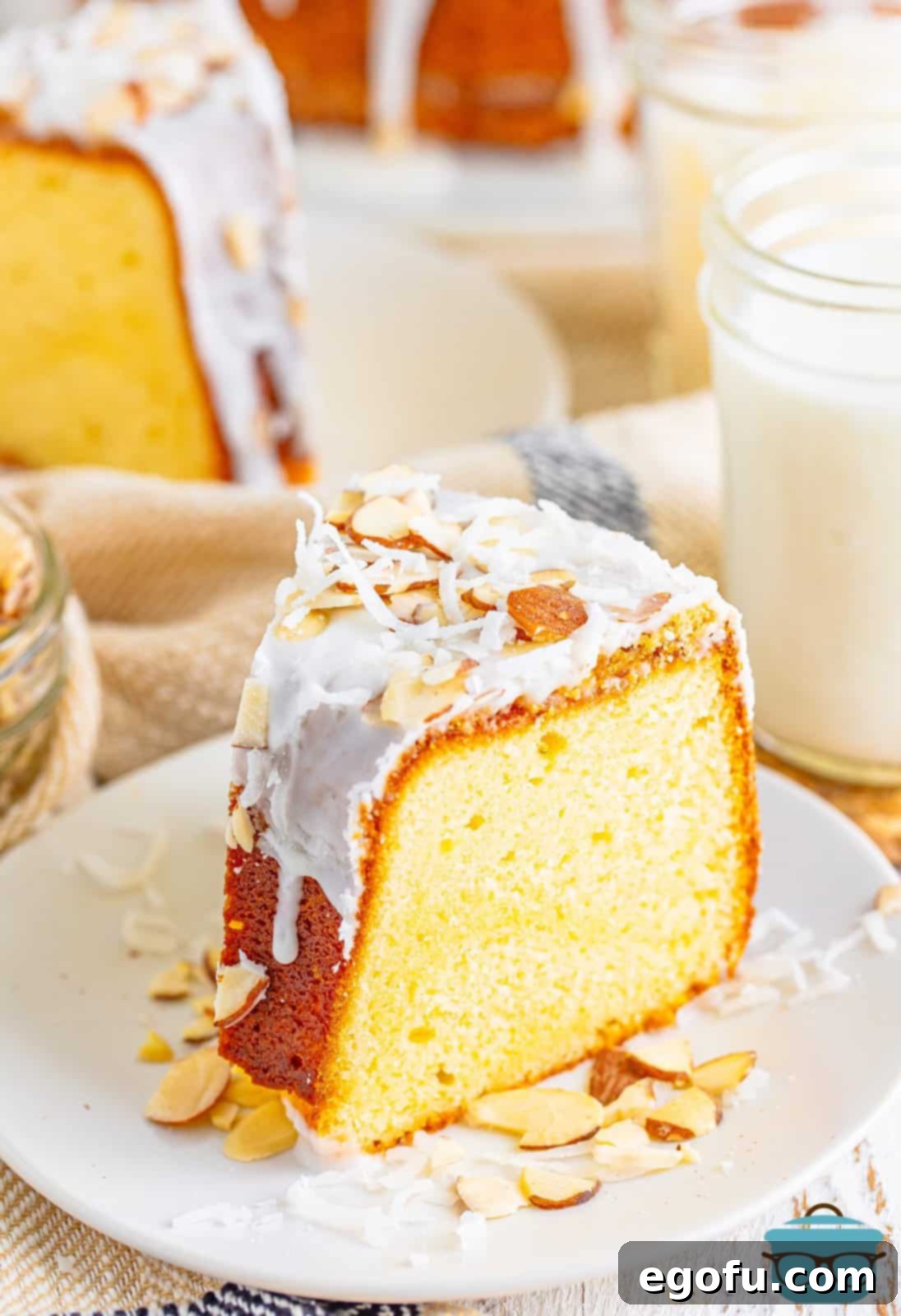
Craving More Southern Sweetness? Explore These Delicious Recipes!
- Southern Pound Cake
- Sock It To Me Cake
- Kentucky Butter Cake
- Pecan Pound Cake
- Southern Pecan Praline Cake
- Watergate Cake
- Cinnamon Roll Cake
- Italian Love Cake
- White Texas Sheet Cake
- Kentucky Derby Pie
- Snickerdoodle Bundt Cake

Recipe: Louisiana Crunch Cake
A show-stopping Southern dessert featuring a tender, buttery pound cake with a delightful crunch from coconut and sliced almonds, finished with a sweet glaze.
Prep Time: 15 minutes
Cook Time: 1 hour
Total Time: 1 hour 15 minutes
Servings: 12 servings
Author: Brandie Skibinski
Print Recipe | Pin Recipe
Ingredients
For the Cake:
- 3 cups all-purpose flour
- 2 teaspoons baking powder
- ½ teaspoon salt
- 2 cups granulated sugar
- 1 cup salted butter, softened to room temperature
- 4 large eggs
- ¼ cup sour cream
- 1 tablespoon vanilla extract
- ½ teaspoon almond extract
- 1 cup buttermilk
For the Cake Topping (in the pan):
- ¼ cup granulated sugar
- ¼ cup sweetened flaked coconut
For the Glaze:
- 2 cups powdered sugar
- 3-4 tablespoons milk (adjust for consistency)
- ¼ teaspoon almond extract
- ¼ teaspoon coconut extract
- ¼ teaspoon vanilla extract
- Pinch of salt
For the Garnish:
- ¼ cup sweetened coconut flakes
- ¼ cup sliced almonds
Instructions
- Preheat your oven to 350°F (175°C). Thoroughly spray a 10-inch tube pan with cooking spray (preferably with flour) and set aside.
- In a medium bowl, whisk together the all-purpose flour, baking powder, and salt. Set aside.
- In the bowl of a stand mixer with the paddle attachment (or using a large bowl and a hand mixer), cream together the granulated sugar and softened salted butter for 2 minutes on medium speed.
- Add the large eggs one at a time, mixing well after each addition until fully incorporated.
- Stir in the sour cream, vanilla extract, and almond extract until just combined.
- Begin adding the dry ingredient mixture to the wet mixture in three equal parts, alternating with the buttermilk. Add one-third of the flour mixture, mix until just combined, then add one-third of the buttermilk, mixing again. Repeat two more times, ending with the flour mixture. Ensure all ingredients are well blended, scraping down the sides and bottom of the bowl as needed to achieve a smooth batter.
- For the cake topping: Sprinkle ¼ cup of granulated sugar evenly into the greased tube pan. Tap and rotate the pan to coat the bottom and about 3 inches up the sides. Then, evenly sprinkle ¼ cup of sweetened flaked coconut into the bottom of the pan.
- Carefully spread the cake batter into the prepared pan and smooth the top.
- Bake for 50-60 minutes, or until a toothpick inserted into the center of the cake comes out clean.
- Remove the cake from the oven and allow it to cool in the pan on a wire rack for 10 minutes.
- Invert the cake onto your serving platter or cake stand and allow it to cool completely before glazing.
- Once the cake is completely cool, prepare the glaze: In a medium bowl, whisk together the powdered sugar, 3 tablespoons of milk, almond extract, coconut extract, vanilla extract, and a pinch of salt until smooth and pourable. If the glaze is too thick, add up to 1 tablespoon more milk, one teaspoon at a time, until the desired consistency is reached.
- Pour the glaze evenly over the top of the cooled cake, allowing it to drip attractively down the sides.
- Immediately sprinkle the remaining ¼ cup of sweetened coconut flakes and ¼ cup of sliced almonds over the wet glaze. This ensures they adhere to the cake as the glaze sets.
- Allow the glaze to set for at least 1 hour before slicing and serving.
Notes
- Refer to the Frequently Asked Questions and ingredient list above for detailed substitutions or answers to common baking queries.
- A 10-inch tube pan is ideal for this recipe. If using a Bundt pan, ensure it has an extra-large capacity (around 15 cups) to prevent overflow, as standard Bundt pans are often too small for this volume of batter.
- If you dislike any of the extract flavors (almond or coconut), feel free to omit them, though they contribute significantly to the cake’s unique profile.
- This stunning cake, with its elegant drippy glaze and crunchy toppings, is perfect for special gatherings such as wedding receptions, baby showers, or holiday celebrations.
- Store leftover cake at room temperature in an airtight container for up to 5 days. For longer preservation, the cake can be frozen for up to 3 months when properly wrapped.
Nutrition Information
Calories: 555 kcal | Carbohydrates: 86g | Protein: 7g | Fat: 21g | Sodium: 276mg | Fiber: 2g | Sugar: 60g
Nutritional Disclaimer
“The Country Cook” is not a certified dietician or nutritionist, and any nutritional information provided is an estimate. If calorie count and other nutritional values are crucial to your dietary needs, we recommend inputting the ingredients into your preferred online nutritional calculator. Please note that nutritional values can vary significantly based on the specific brands and types of ingredients used.
Did you make this recipe?
Share your creation on Instagram @thecountrycook and mention us #thecountrycook!
